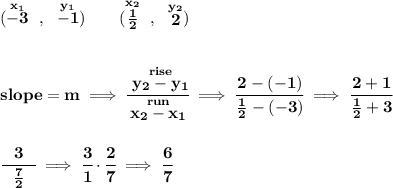
![\bf \begin{array}ll \cline{1-1} \textit{point-slope form}\\ \cline{1-1} \\ y-y_1=m(x-x_1) \\\\ \cline{1-1} \end{array}\implies y-(-1)=\cfrac{6}{7}[x-(-3)] \\\\\\ y+1=\cfrac{6}{7}(x+3)\implies y+1=\cfrac{6}{7}x+\cfrac{18}{7}\implies y=\cfrac{6}{7}x+\cfrac{18}{7}-1 \\\\\\ y=\cfrac{6}{7}x+\cfrac{11}{7}](https://img.qammunity.org/2019/formulas/mathematics/middle-school/x3tvi9uh4bqp2e6vgipgj1nktwj5tacft1.png)
now, let's bear in mind that
standard form for a linear equation means
• all coefficients must be integers, no fractions
• only the constant on the right-hand-side
• all variables on the left-hand-side, sorted
• "x" must not have a negative coefficient
so, let's multiply both sides by the LCD of all fractions, in this case that'd be 7, to do away with the denominators.
![\bf \stackrel{\textit{multiplying both sides by }\stackrel{LCD}{7}}{7(y)=7\left( \cfrac{6}{7}x+\cfrac{11}{7} \right)}\implies 7y=6x+11\implies -6x+7y=11 \\\\[-0.35em] \rule{34em}{0.25pt}\\\\ ~\hfill 6x-7y=-11~\hfill](https://img.qammunity.org/2019/formulas/mathematics/middle-school/m4jf4aha6c7hu8s2vgxxkm0oibg7j8ubqt.png)